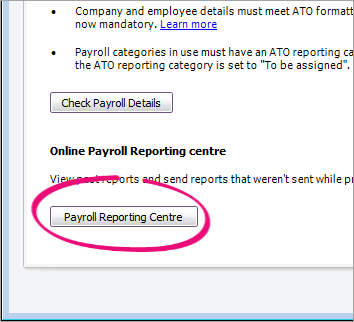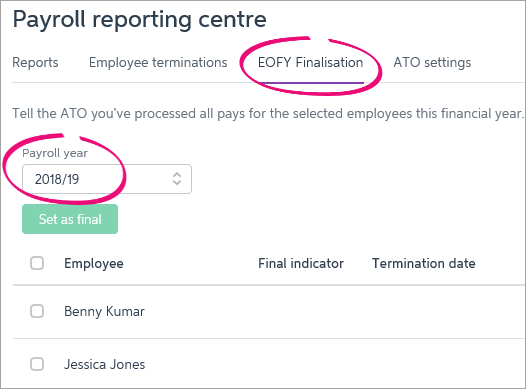- Created by MichelleQ, last modified by AdrianC on Jun 16, 2022
You are viewing an old version of this page. View the current version.
Compare with Current View Page History
« Previous Version 190 Next »
https://help.myob.com/wiki/x/2YPtB
How satisfied are you with our online help?*
Just these help pages, not phone support or the product itself
Why did you give this rating?
Anything else you want to tell us about the help?
AccountRight Plus and Premier, Australia only
Superannuation guarantee changes from 1 July 2022
- The minimum super guarantee rate increases to 10.5%. Find out how to automatically stay compliant
- The $450 earnings threshold for super guarantee eligibility has been removed. Find out more
- Enter all pays up to 30 June (pays recorded in July which include June pay dates aren't included in the finalised year)
- Fix any incorrect pays
- Check that pay runs sent during the payroll year have been accepted by the ATO.
- Note that rejected reports retain a Rejected status. This is OK if reports since the rejected one have been accepted by the ATO.
What happens when I finalise?
- You'll start by checking your year-to-date totals to make sure you've reported everything correctly to the ATO.
- You'll let the ATO know that you've completed all pays for the payroll year.
- The status of the employee's income statement in myGov changes to Tax ready so they can pre-fill and lodge their tax return.
If you're stuck or feeling unsure, try our free eLearning to discover everything you need to know about finalising your payroll information.
Check your year-to-date totals
Before finalising, you should check that the year-to-date (YTD) amounts you've sent to the ATO for the payroll year match the payroll figures in AccountRight.
Do this by comparing two reports to ensure they match:
- the YTD verification report in the Payroll Reporting Centre—this shows the YTD amounts you've reported to the ATO
- the Payroll Summary report in AccountRight—this shows the YTD amounts you've processed through payroll in AccountRight
- Go to the Payroll command centre and click Payroll Reporting.
- Click Payroll Reporting Centre.

- If prompted, sign in using your MYOB account details (email address and password).
- Click the the EOFY Finalisation tab.
- Choose the Payroll year. The Gross Payments (YTD) and PAYG withholding (YTD) values are the total amounts sent to the ATO for all your employees.
- Click YTD verification report.

The report displays as a PDF. Take note of the total salary and wages YTD amount. Here's an example:
What am I looking at?
- This report shows the total of all ATO reporting category amounts sent to the ATO for all employees.
- The Reconciliation to Payroll section is not sent to the ATO. It shows total gross wages which you'll also see in the Payroll Summary report in AccountRight. This amount will differ from the total gross wages reported to the ATO, as it doesn’t include Allowances, CDEP, Foreign Income, ETP components (not ETP Tax), Lump Sum values or any additional reimbursable/employee expenses.
- The ATO Reporting Category section lists the things that have been submitted to the ATO.
- The Total STP gross wages (in the ATO Reporting Category section) doesn't include allowances. This amount should be the same as what's shown in your Payroll Summary report in AccountRight, minus any allowances or the other pay components which are listed in the Reconciliation to Payroll section.
- An employee's reportable fringe benefit amounts are reported to the ATO when you finalise, so these won't display on the YTD verification report until after you've completed the finalisation.
Do you notice ETP values don't look right?
- In AccountRight, go to the Reports menu and choose Index to Reports.
- Click the Payroll tab on the left.
- Under Payroll Categories, click the Payroll Summary report.
- Filter the report to show Year-to-Date for This Year, and dated from 1 July to 30 June.

- Click Display Report and check the YTD total for wages. Here's our example:

It's better in a browser
Click Open in web browser in AccountRight to access your company file in a web browser. You'll have access to an improved version of the Payroll Summary report, where salary and wage amounts are grouped by ATO reporting category.
After you've run the above reports, compare the YTD total wage amounts on both. If they match (like in our example), you're ready to finalise.

If the reports don't match
Here are some things to check.
Make sure you've assigned an ATO reporting category to each of your payroll categories. The easiest way to check if anything is missing is to let AccountRight do it for you.
- Go to the Payroll command centre and click Payroll Reporting.
- Click Check Payroll Details.

AccountRight will let you know if there are any payroll categories that need an ATO reporting category assigned—like this example:

- If any payroll categories are listed:
- Click the zoom arrow to open the payroll category.
- Assign the applicable ATO Reporting Category. For help choosing the right one, see Assign ATO reporting categories for Single Touch Payroll reporting or speak to your accounting advisor.
- Click OK.
- Back on the Check Payroll Details window, click Check Payroll Details to run the check again.
If you add or change the ATO reporting category in a payroll category, send an update event to the ATO as described below.
Use Find transactions to identify employees who have been paid a specific payroll category during the payroll year (Payroll command centre > Find transactions > Search by Payroll Category > choose the payroll category > enter dates from 1 July to 30 June).
Once all payroll categories are assigned an ATO reporting category, run the YTD verification and Payroll Summary reports again (as we did above) to ensure they match. If they do, you're ready to finalise. Otherwise, check the reported wage values for each employee as shown below to narrow down where your issue might be.
There are three reports you (or your accounting advisor) can use to check the amounts paid to individual employees for the payroll year.
- In AccountRight, run and compare the Payroll Register Detail and Payroll Activity Detail reports (Reports menu > Index to Reports > Payroll tab).

- In the Payroll Reporting Centre, click the ellipsis
 button for an employee and choose Download report(PDF). This report shows a summary of all ATO reporting category amounts sent to the ATO for an employee (gross payments, PAYG withholding, allowances, etc.).
button for an employee and choose Download report(PDF). This report shows a summary of all ATO reporting category amounts sent to the ATO for an employee (gross payments, PAYG withholding, allowances, etc.).
Here's what these reports show and what to look for:
| Report | Description |
|---|---|
In AccountRight: Payroll Register Detail and Payroll Activity Detail | The Payroll Register Detail report gets its information from the pay history in your employee cards, but the Payroll Activity report gets its information from the pays you've run in AccountRight. If these reports don't match, it's likely due to the pay history in an employee's card being changed (Card File > Cards List > Employee tab > open the employee's card > Payroll Details tab > Pay History). If you've made a mistake in a pay, don't try to fix it by changing the Pay History in an employee's card. Instead, fix it by adjusting the employee's next pay. See Changing a recorded pay, Adjusting leave entitlements and Viewing pay history for the current year for all the details. Here's a quick overview: Note that the total wages in the Payroll Register Detail report includes all payroll categories and doesn't reduce the total wages by any non-taxable deduction or wage categories, and payroll categories that don't have an ATO reporting category. See an example. |
In the Payroll Reporting Centre: Summary of Payments | The gross payments amount is reduced by any non-taxable deduction or wage categories, and payroll categories that don't have an ATO reporting category. See an example. If an employee's ETP values don't look right in the report, you might have tried to fix their ETP payment by recording an adjustment pay. If this is the case, find out how to fix it. |
To ensure the latest year-to-date amounts are sent to the ATO for an employee, you can send an update event as described below.
Send an update event
An update event is where you send your employees' latest year to date payroll totals to the ATO. This ensures your payroll totals in MYOB sync with the figures held by the ATO.
If you're reporting via STP Phase 2, you can send an update event from the STP reporting centre. Otherwise you'll need to record a zero dollar ($0) pay for each employee whose year to data payroll totals you want to send to the ATO.
Am I reporting via STP Phase 2?
If you're on STP Phase 2, you'll see the Send update event button in the STP reporting centre (Payroll command centre > Payroll reporting > Payroll Reporting Centre). If you don't see this button, you're on STP Phase 1.

- Go to the Payroll command centre and click Payroll Reporting.
- Click Payroll Reporting Centre.

- If prompted, sign in using your MYOB account details (email address and password).
- Click the STP reports tab.
- Choose the applicable Payroll year.
- Click Send update event.

- When prompted, enter your details and click Send.
Once the update event has been accepted by the ATO, run the above reports again to confirm the totals match.
You can send an update event for an employee by recording a $0 pay for them. This type of pay is also called a void pay and it's like any other pay, but you'll enter zero for all hours and amounts.
When you record a $0 pay, the employee's latest year to date payroll totals will be sent to the ATO.
- Start a new pay run (Payroll > Process Payroll). Need a refresher?
- Choose the employee you're sending the update event for.
- Ensure the Payment Date is in the payroll year you're sending the update event for.
- Click the blue zoom
 arrow to edit the employee's pay.
arrow to edit the employee's pay. - Remove all hours and amounts from the employee's pay, like this example.

- Complete the pay run as you normally do and declare it to the ATO. Need a refresher?
Once the pay run has been accepted by the ATO, run the above reports again to confirm the totals match.
Reports still don't match? You might need help from an expert to dig a little deeper into your issue. Reach out to your accounting advisor, or try the MYOB professionals on our community forum. Of course, you can always get help from our support team.
As part of processing an employee's final pay, you need to notify the ATO. This lets the ATO know the employee's termination date and any ETP components in their final pay.
Which steps do I follow?
How you notify the ATO of the termination depends on whether you're set up for STP Phase 1 or STP Phase 2. If you set up STP after mid-December 2021, you're likely on STP Phase 2.
The easiest way to check is to look in one of your wage categories:
- Sign in to your company file and go to the Payroll command centre > Payroll Categories.
- Click the zoom arrow
 to open a wage category.
to open a wage category. - Check how many ATO Reporting Category fields there are.
- If there are two ATO Reporting Category fields (and a message about "STP Phase 2 is coming", you're on STP Phase 1 — which is fine!
- If there's only one ATO Reporting Category field, your file is set up for STP Phase 2.

To notify the ATO of terminated employees
- Go to the Payroll command centre and click Payroll Reporting.
- Click Payroll Reporting Centre.
- Click the Employment terminations tab.
- Select the employee who's leaving, choose their last day of employment, then click Notify the ATO.

- When prompted to send your payroll information to the ATO, enter your details and click Send.
This declaration is processed in the same way other Single Touch Payroll reports are. They need to have a status of Accepted in the payroll reporting centre before you can finalise your STP information.
- Go to the Payroll command centre and click Payroll Reporting.
- Click Payroll Reporting Centre.
- If prompted, sign in using your MYOB account details (email address and password).
- Click the Employee terminations tab.
- Choose the applicable Payroll year and click Add Termination.
- Enter the termination details and click Notify the ATO.

- When prompted to send your payroll information to the ATO, enter your details and click Send.
This declaration is processed in the same way other Single Touch Payroll reports are. They need to have a status of Accepted in the payroll reporting centre before you can finalise your STP information.
Finalising your Single Touch Payroll information is done in just a few clicks.
- Go to the Payroll command centre and click Payroll Reporting.

Click Payroll Reporting Centre.

If this button says Connect to ATO, it means the company file hasn't been set up for Single Touch Payroll, or you haven't added yourself as a declarer for STP.
- If prompted, sign in using your MYOB account details (email address and password).
- Click the EOFY Finalisation tab and choose the Payroll year you're finalising.

- If you need to report fringe benefits for an employee (what is this?):
- Click the ellipsis
 button for the employee and choose Enter RFBA.
button for the employee and choose Enter RFBA. Enter in both the:
Reportable fringe benefits amount $
Reportable fringe benefits amount exempt from FBT under section 57A $
The combined value of these must be above the thresholds set by the ATO.
- Click Add amounts.
- Click the ellipsis
- Select each employee you want to finalise, then click Set as Final.
- Enter the name of the Authorised sender and click Send.
What's next?
Each employee that has been finalised will have the Final indicator ticked in the payroll reporting centre. You can let these employees know that they can now sign in to myGov to complete their tax returns. That's right—you don't need to complete payment summaries for them!.
Providing you're using the latest AccountRight version, you're ready to start processing pays from 1 July for the new payroll year. The latest tax tables will automatically apply so you don't have to worry about downloading them. Also learn about the new option in AccountRight to keep you compliant with super guarantee rate increases.
FAQs
Why don't my STP reports match the ATO's Business Portal?
Each STP report sent to the ATO includes the employer pay period information and the employee year-to-date (YTD) amounts.
As the ATO doesn't allow you to delete these reports, the Business Portal will show every pay run declared through STP, including ones that you have deleted or reversed in your software.
So, in most cases, if you've made payroll adjustments the Business Portal may not match your STP reports. And that's OK. Just make sure you check year-to-date totals in AccountRight before finalising. See To check year-to-date totals, above.
Why is an employee missing from the EOFY Finalisation list?
Only employees who have been paid in the current payroll year appear in the EOFY Finalisation list. If an employee isn't listed, check that:
- the employee's Employment Basis is set to Individual or Labour Hire. You'll find this setting in the Payroll Details tab > Personal Details of the employee's card.
- at least one pay been recorded for the year, after setting up STP.
If you've checked these things and an employee still isn't showing, send an update event to the ATO as described above. This sends the employee's YTD amounts to the ATO and the employee will appear in the finalisation list.
How do I undo a finalisation?
When you undo an employee's finalisation, their income statement in myGov will no longer be Tax ready so they won't be able to pre-fill and lodge their tax return.
- Go to the Payroll command centre and click Payroll Reporting.
- Click Payroll Reporting Centre.
- Click the EOFY Finalisation tab.
- Choose the Payroll year.
- Remove the finalisation. How you do this depends on what you see.
- If there's an ellipsis
 button next to the employee, click it and choose Remove finalisation.
button next to the employee, click it and choose Remove finalisation. - If there is no ellipsis button, select the employee and click Remove finalisation and notify the ATO.
- If there's an ellipsis
- When prompted to send your payroll information to the ATO, enter your details and click Send. The Final indicator tick is removed for the employee. If it's still there, click a different tab then return to the EOFY Finalisation tab.
- When you're ready, you can finalise the employee again.
How do I remove an ETP from the Payroll Reporting Centre?
Reverse the pay in AccountRight and you’ll be prompted to submit the reversal to the ATO for STP reporting. This will automatically remove the incorrect payment.



 Yes
Yes
 No
No
 Thanks for your feedback.
Thanks for your feedback.